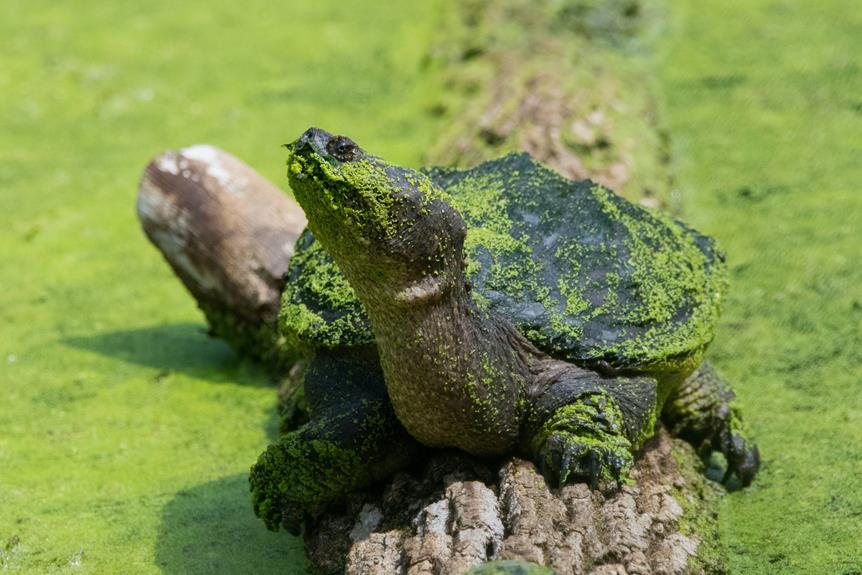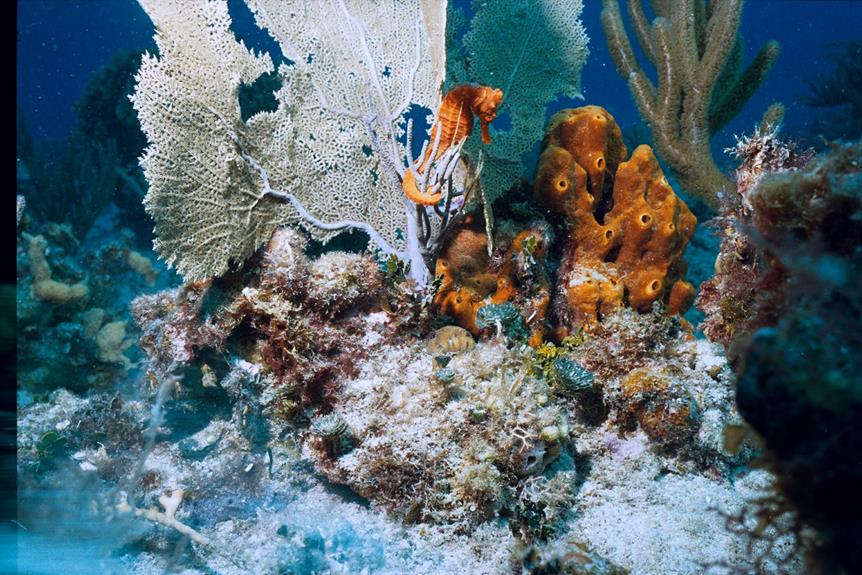Crafting the ideal indoor habitat for your Red-Eared Slider turtle is a task that requires thoughtful planning and attention to detail. From the tank size to the lighting setup, each element plays a crucial role in ensuring the well-being of your aquatic pet.
But what specific considerations should you keep in mind to create a setup that mirrors their natural environment? How can you strike a balance between functionality and aesthetics in your turtle's enclosure?
Let's explore the key components of the best indoor setup for a Red-Eared Slider turtle, guiding you towards providing a comfortable and stimulating environment for your shelled companion.
Key Takeaways
- Choose a suitable tank with proper filtration and amenities for a thriving red-eared slider turtle habitat.
- Ensure secure tank covers to prevent escapes and provide ventilation.
- Maintain optimal lighting and basking areas for the turtle's health and well-being.
- Regularly upkeep the habitat with water quality checks, temperature monitoring, and cleaning routines.
Tank Setup Options
When considering the setup for a red-eared slider turtle, the options for tank configurations range from small aquariums suitable for beginners to larger tanks or even full-size ponds depending on the number and size of turtles to be housed. Filter system options are crucial for maintaining water quality, with choices like canister filters or internal filters available.
Tank decoration ideas can include artificial plants, rocks, driftwood, or caves to create a naturalistic environment. Providing a basking area with a heat lamp is essential, along with a UVB light for their health. Substrate such as aquatic gravel can be used, and an air pump can help with oxygenation.
Proper tank setup is vital for the well-being of red-eared slider turtles.
Tank Cover Recommendations
A crucial element in ensuring the containment and security of red-eared slider turtles within their habitat is the selection of an appropriate tank cover. When considering tank cover options, here are some recommendations to enhance the safety and well-being of your turtles:
- Metal Tank Covers: Commonly used to prevent turtles from escaping.
- Mesh Covers: Provide ventilation while ensuring the turtles stay inside.
- Sliding Glass Covers: Offer a clear view while keeping the turtles securely enclosed.
- DIY Alternatives: Consider creating a custom cover using sturdy materials like plexiglass or wire mesh for a cost-effective solution.
Tank Amenities Essentials
To ensure a well-rounded habitat for red-eared slider turtles, providing essential tank amenities is crucial for their overall health and comfort. Aquatic plant options can be added to the tank to mimic a natural environment, providing hiding spots and enriching the turtle's surroundings.
When it comes to water filtration solutions, a good quality filter is essential to maintain water quality and keep the tank clean. Consider options like a canister filter or a power filter, ensuring proper filtration to support the turtle's well-being.
These amenities not only enhance the aesthetic appeal of the tank but also contribute to creating a suitable and thriving habitat for your red-eared slider turtle.
Lighting Requirements for Turtles
Proper lighting is essential for meeting the specific requirements of Red-Eared Slider turtles in creating a suitable habitat for their overall well-being and health. When setting up the lighting for your turtle enclosure, consider the following:
- UVB lighting benefits: Red-Eared Sliders require UVB light to help them metabolize calcium and maintain healthy shell growth.
- Heat lamp considerations: A heat lamp is essential to provide warmth, especially for basking areas where turtles can regulate their body temperature.
- Lighting schedule: Ensure a consistent lighting schedule mimicking natural sunlight patterns to maintain your turtle's circadian rhythm.
- Lighting placement: Position the lights to create a gradient of heat and UVB exposure, allowing your turtle to choose the right spot for basking and UV absorption.
Basking Area Necessities
For an optimal indoor setup for a Red-Eared Slider turtle, ensuring a suitable basking area with specific necessities is crucial for the overall well-being and health of the turtle.
When creating a basking area, careful consideration should be given to basking spot selection and temperature regulation. The basking platform design is essential, providing a dry and spacious area for the turtle to warm up adequately.
Ensure the basking area is large enough and kept dry to prevent any moisture-related issues. Proper heat lamp placement is key to maintaining the ideal temperature in the basking area, mimicking the warmth of the sun.
Habitat Maintenance Tips
Maintaining an optimal habitat for your Red-Eared Slider turtle involves diligent care and attention to various maintenance tips to ensure a healthy and thriving environment for your pet.
- Water quality: Regularly check and maintain proper water filtration and quality to prevent the buildup of harmful bacteria and contaminants.
- Temperature regulation: Monitor and adjust the water and basking area temperatures as needed to mimic the natural habitat of Red-Eared Sliders.
- Tank cleaning schedule: Establish a consistent cleaning routine to remove waste, uneaten food, and debris from the tank to maintain a clean and hygienic environment.
- Regular health checks: Conduct routine health assessments of your turtle to catch any potential issues early and ensure prompt veterinary care when needed.
Frequently Asked Questions
What Are Some Common Health Issues That Red-Eared Slider Turtles May Face in an Indoor Setup?
Common health issues Red-Eared Slider turtles may face in an indoor setup include shell rot, respiratory infections, and metabolic bone disease. Preventive care involves maintaining proper hygiene, water quality, and providing adequate basking and lighting. Treatment options vary based on the specific health concern.
Can Red-Eared Slider Turtles Cohabitate With Other Turtle Species in the Same Tank?
When considering turtle compatibility in the same tank, it is crucial to assess tank size to avoid territorial disputes. Behavioral interactions and aggression levels should be monitored closely. Providing ample space and separate basking areas can help mitigate potential conflicts.
How Often Should the Tank Water Be Changed and Cleaned for Optimal Turtle Health?
Regular cleaning and water changes are essential for optimal turtle health. Maintain water quality with a reliable filtration system. Enrich the tank with decorations for mental and physical stimulation. Follow a routine schedule to ensure a clean and healthy environment for your Red-Eared Slider turtle.
Are There Any Specific Dietary Requirements or Feeding Schedules for Red-Eared Slider Turtles in an Indoor Setup?
In an indoor setup, Red-Eared Slider turtles require a balanced diet of commercial turtle pellets, leafy greens, and occasional protein sources like insects. Dietary supplements like calcium and vitamin D3 should be provided regularly to meet their nutritional needs. Feeding should occur daily with portion sizes adjusted to avoid overfeeding.
What Are Some Potential Behavioral Signs That Indicate a Red-Eared Slider Turtle Is Stressed or Unhappy in Its Habitat?
Signs of stress in Red-Eared Slider turtles include shell discoloration, decreased appetite, aggressive behavior, and excessive hiding. Monitoring behaviors closely in their habitat is crucial to ensure their well-being and prompt intervention if needed.
Conclusion
In conclusion, creating an optimal habitat for a Red-Eared Slider turtle requires careful attention to detail in tank setup. By providing adequate space, cover, amenities, lighting, and a designated basking area, you can ensure the well-being and happiness of your aquatic companion.
Remember to regularly maintain the habitat to keep it clean and safe for your turtle. With the right setup, your Red-Eared Slider turtle can thrive in its indoor environment.





